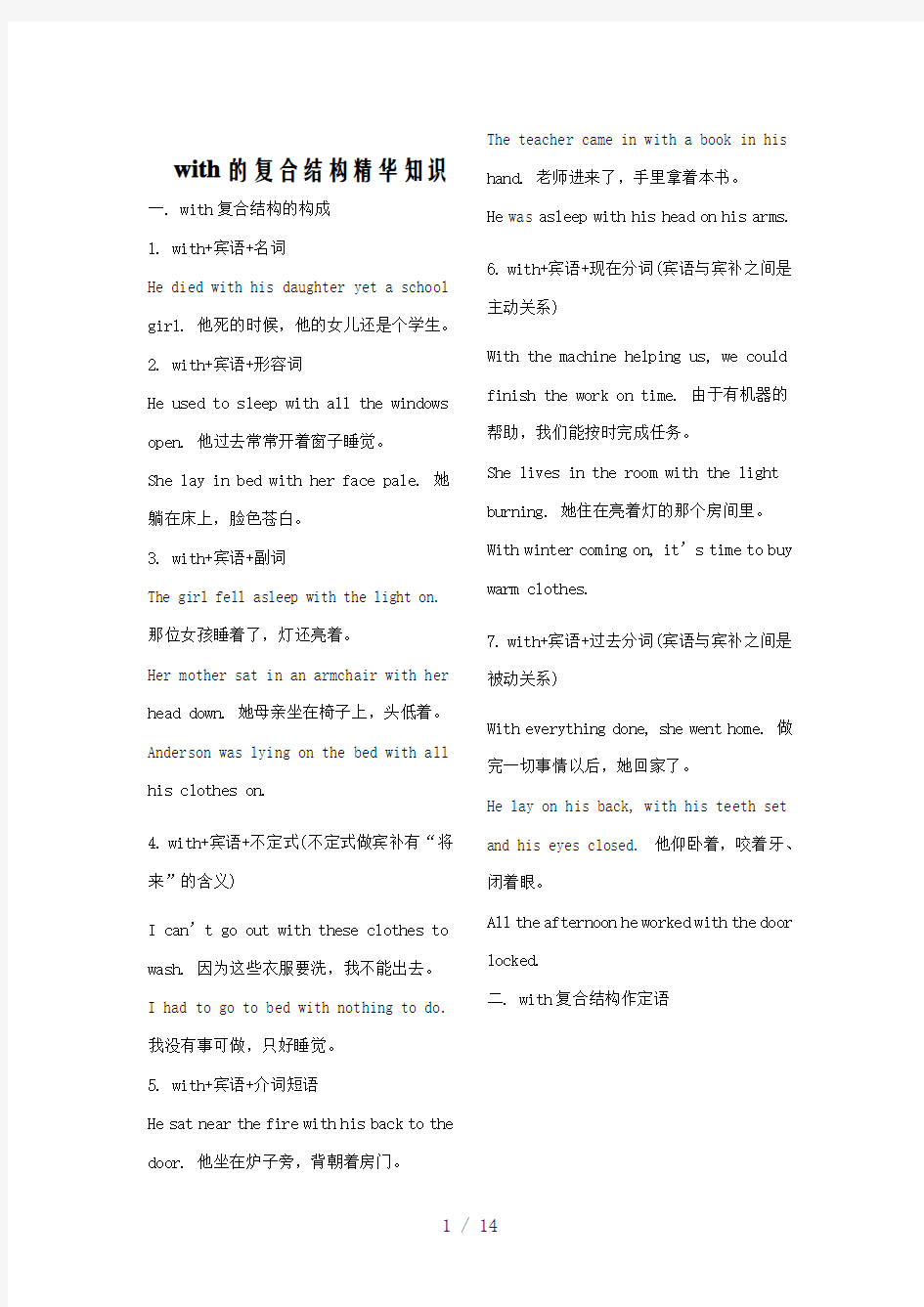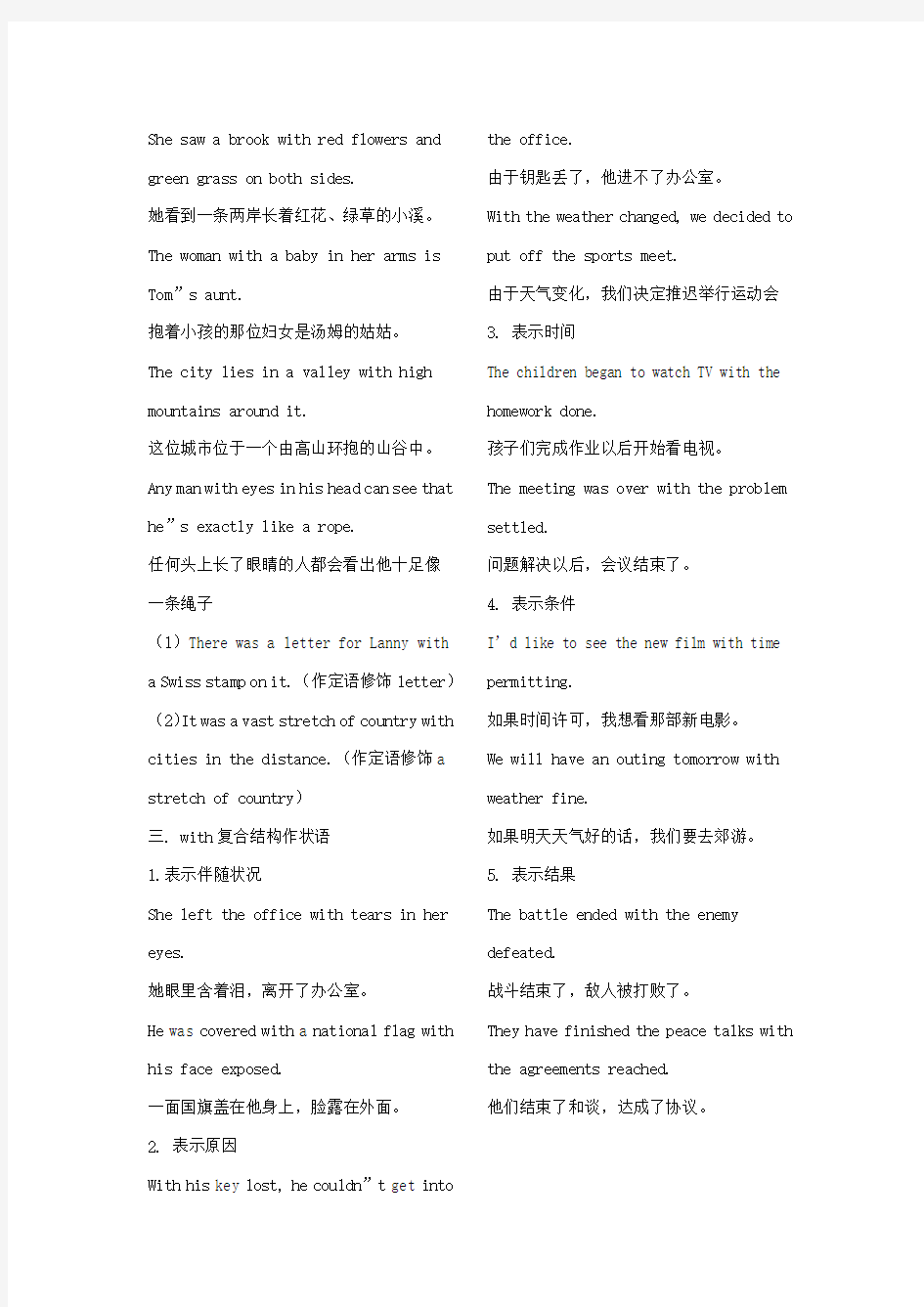with的复合结构


with的复合结构精华知识
一. with复合结构的构成
1. with+宾语+名词
He died with his daughter yet a school girl. 他死的时候,他的女儿还是个学生。
2. with+宾语+形容词
He used to sleep with all the windows open. 他过去常常开着窗子睡觉。
She lay in bed with her face pale. 她躺在床上,脸色苍白。
3. with+宾语+副词
The girl fell asleep with the light on. 那位女孩睡着了,灯还亮着。
Her mother sat in an armchair with her head down. 她母亲坐在椅子上,头低着。Anderson was lying on the bed with all his clothes on.
4. with+宾语+不定式(不定式做宾补有“将来”的含义)
I can’t go out with these clothes to wash. 因为这些衣服要洗,我不能出去。
I had to go to bed with nothing to do. 我没有事可做,只好睡觉。
5. with+宾语+介词短语
He sat near the fire with his back to the door. 他坐在炉子旁,背朝着房门。The teacher came in with a book in his hand. 老师进来了,手里拿着本书。
He was asleep with his head on his arms.
6. with+宾语+现在分词(宾语与宾补之间是主动关系)
With the machine helping us, we could finish the work on time. 由于有机器的帮助,我们能按时完成任务。
She lives in the room with the light burning. 她住在亮着灯的那个房间里。With winter coming on, it’s time to buy warm clothes.
7. with+宾语+过去分词(宾语与宾补之间是被动关系)
With everything done, she went home. 做完一切事情以后,她回家了。
He lay on his back, with his teeth set and his eyes closed. 他仰卧着,咬着牙、闭着眼。
All the afternoon he worked with the door locked.
二. with复合结构作定语
She saw a brook with red flowers and green grass on both sides.
她看到一条两岸长着红花、绿草的小溪。The woman with a baby in her arms is Tom”s aunt.
抱着小孩的那位妇女是汤姆的姑姑。
The city lies in a valley with high mountains around it.
这位城市位于一个由高山环抱的山谷中。Any man with eyes in his head can see that he”s exactly like a rope.
任何头上长了眼睛的人都会看出他十足像
一条绳子
(1)There was a letter for Lanny with a Swiss stamp on it.(作定语修饰letter)(2)It was a vast stretch of country with cities in the distance.(作定语修饰a stretch of country)
三. with复合结构作状语
1.表示伴随状况
She left the office with tears in her eyes.
她眼里含着泪,离开了办公室。
He was covered with a national flag with his face exposed.
一面国旗盖在他身上,脸露在外面。
2. 表示原因
With his key lost, he couldn”t get into the office.
由于钥匙丢了,他进不了办公室。
With the weather changed, we decided to put off the sports meet.
由于天气变化,我们决定推迟举行运动会3. 表示时间
The children began to watch TV with the homework done.
孩子们完成作业以后开始看电视。
The meeting was over with the problem settled.
问题解决以后,会议结束了。
4. 表示条件
I’d like to see the new film with time permitting.
如果时间许可,我想看那部新电影。
We will have an outing tomorrow with weather fine.
如果明天天气好的话,我们要去郊游。
5. 表示结果
The battle ended with the enemy defeated.
战斗结束了,敌人被打败了。
They have finished the peace talks with the agreements reached.
他们结束了和谈,达成了协议。
With的复合结构零碎知识 with结构是许多英语复合结构中最常用的一种。学好它对学好复合宾语结构、不定式复合结构、动名词复合结构和独立主格结构均能起很重要的作用。本文就此的构成、特点及用法等作一较全面阐述,以帮助同学们掌握这一重要的语法知识。
一、 with结构的构成
它是由介词with或without+复合结构构成,复合结构作介词with或without的复合宾语,复合宾语中第一部分宾语由名词或代词充当,第二部分补足语由形容词、副词、介词短语、动词不定式或分词充当,分词可以是现在分词,也可以是过去分词。With 结构构成方式如下:
1. with或without-名词/代词+形容词;
2. with或without-名词/代词+副词;
3. with或without-名词/代词+介词短语;
4. with或without-名词/代词 +动词不定式;
5. with或without-名词/代词 +分词。
即with+宾语+宾补
有这些词和短语可以做宾补:1、形容词 2、副词 3、介词短语 4、现在分词 5过去分词6、不定式
with the window closed(closed为形容词) with the light on
with a book in her hand
with a cat lying in her arms
with the problem solved
with the new term to begin
二、With的复合结构作独立主格(重点哦)
表伴随时,既可用分词的独立结构,也可用with的复合结构。
with +名词(代词)+现在分词/过去分词/形容词/副词/不定式/介词短语
举例: He stood there, his hand raised. = He stood there, with his hand raise.
典型例题
The murder was brought in, with his hands ___ behind his back。
A. being tied
B. having tied
C. to be tied
D. tied
答案D. with +名词(代词)+分词+介词短语结构。当分词表示伴随状况时,其主语常常用with来引导。由于本句中名词"手"与分词"绑"是被动关系,因此用过去分词,选D.
注意:
1) 独立主格结构使用介词的问题:
当介词是in时,其前后的两个名词均不加任何成分(如物主代词或冠词),也不用复数。但 with 的复合结构不受此限制
A robber burst into the room, knife in hand.
( hand前不能加his)。
2) 当表人体部位的词做逻辑主语时,及物动词用现在分词,不及物动词用过去分词。 He lay there, his teeth set, his hand clenched, his eyes looking straight up.
典型例题:
Weather___, we'll go out for a walk.
A permitted
B permitting
C permits
D for permitting
答案B. 本题中没有连词,它不是复合句,也不是并列句。句中使用了逗号,且we 小写,可知其不是两个简单句。能够这样使用的只有独立主格或with的复合结构。据此判断,本句中使用的是独立结构,其结构为:名词+分词。由于permit在这里翻译为'天气允许',表主动,应用现在分词,故选B。
如果不会判断独立结构作状语的形式,不妨将句子改为条件句,例如本句改为If weather permits, we'll go out for a walk. 然后将if 去掉,再将谓语动词改为非谓语动词即可。
三、with sth to do是主动形式表被动含义
With so many problems to settle, the new manager was too worried to eat anything.为什么这里不用to be settled啊,为什么不是被动啊
这一题主要考查的是介词with所构成的复合结构,但同时又考查动词不定式的用法。
有两种解释,
1.本来with的复合结构中用不定式,就可以用to do表被动和将来的意义,不用 to be done。
2.因为settle的逻辑主语the new manager 在这个句子中出现了,所以就可以用to do 表被动。比如Do you have anything to be bought? 这里就表示不是you你买,而是我或者他人帮你买,Do you have anything to buy? 这里就表示你买。
在英语中,如果在句子中能找到动词不定式的逻辑主语动词不定式往往用主动式而不用被动式;若在句子中找不到动词不定式的逻辑主语就用不定式的被动式。在这个句子中,很明显能够找到动词不定式的逻辑主语(the manager),所以不定式用主动式不用被动式。
四、表示将要发生的事With much homework to do,he will not play football with his friends this afternoon.
五、拓展find的复合结构
1. find +宾语+现在分词
She found a wallet lying on the ground. 她发现一只钱包在地上。
If slaves were found living together secretly they were cruelly whipped.
如果奴隶们被发现私自同居,就会受到残酷鞭打。
For most of the day he can still be found working somewhere in the plant.
白天大部分时间人们还发现他在厂里某个
地方工作。
He was heartened to find the people living better than ever before.
看到人民生活比过去任何时候都好,他由衷地感到高兴。
2. find +宾语+过去分词
He found the place much changed.
他发现这地方有了巨大的变化。
We found her quite recovered.
我们发现她已完全痊愈。
They found the street lined with people. 他们发现大街两侧都站着人。
Two of the windows were found broken. 发现有两扇玻璃窗被打破了。
Both doors were found locked.
发现两扇门都被锁上了。
3. find +(宾语)+形容词
She was found alone in the room.
发现她一个人在屋里。
He was found dead in the morning.
早上人们发现他已经死了。
I find idioms and useful expressions hard to learn.
我发现习语和有用的短语很难学。
Have you found anything wrong in the article?
文章中你已经发现什么错误了吗?
Which do you find hardest,listening, speaking, reading or writing?
你觉得听、说、读、写哪一方面最难?
4. find +宾语+副词
I
